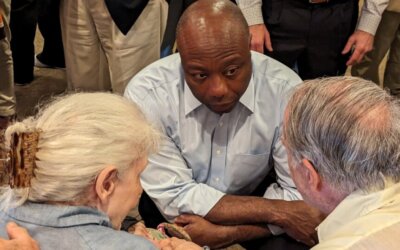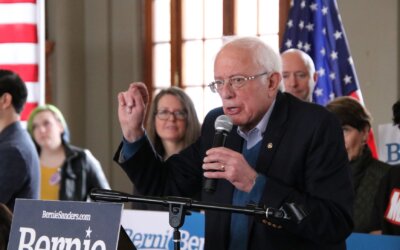
The Democratic presidential field got its 14th contestant this morning when former Colorado Governor John Hickenlooper made his bid official. We also saw a rare decision to not run, this time from former Attorney General Eric Holder. The number of White House hopefuls should jump to 15 as early as tomorrow with Beto O’Rourke’s announcement.
That, to put it lightly, is a lot of candidates. We’re not up to the 17 contenders that Republicans fielded in their 2016 primary, but Democrats should easily surpass that by the end of March.
Just how many people could eventually get into the race? Let’s take a look at the likely options. If you follow Starting Line on Twitter, we’ve put out regular updates of where the potential field stands. There’s lots of little signs – trips to Iowa, early staffing, and candidacy preview stories – that can tell us who’s on the verge of announcing and who’s still really not sure.
Let’s go through some of our categories to get a sense of where the Democratic primary could end up.
Definitely About To Run – 2
Both Eric Swalwell and Beto O’Rourke seem primed and ready to announce. That takes the field up to 16.
Staffers for Swalwell have already been laying the groundwork in Iowa for months, and the California Congressman visited Iowa extensively during the midterms. O’Rourke recently stated he wouldn’t run for the Senate. He appears to be putting together his team and will get in this week.
Probably Will Run – 3
This category contains Democrats who seem to be very likely to run, but who could maybe change their mind at the last minute. It includes Joe Biden, Sherrod Brown, and Steve Bullock.
Brown and Bullock both have staff from their PACs in Iowa already. I would say they’re almost certain to enter the race, though Brown sounded legitimately unsure when asked in Iowa (that was a month ago, however) – I still tend to take these people at their word. Bullock appears to be waiting on the Montana Legislature to adjourn on May 1 to announce. He too has passed on a Senate run, but there’s still some time between now and May for something to come up and he changes his mind.
Still, there’s like a 90% chance all three run, which takes the field up to 19.
Maybe – 10
There’s a lot of other Democrats who have made a few early state stops, publicly considered a presidential campaign, or who haven’t ruled themselves out among heavy speculation. They are, in no particular order:
Jeff Merkley
Terry McAuliffe
Tim Ryan
Joe Sanberg
Bill de Blasio
Michael Bennet
Seth Moulton
Stacey Abrams
Andrew Cuomo
Michael Bloomberg
Let’s start with the least likely. I don’t think Senator Jeff Merkley will do it, he just hasn’t said so publicly yet. A frequent visitor to Iowa in the midterms who placed staff here, he hasn’t been back since the Oregon Legislature decided he couldn’t run for reelection to the Senate and for the presidency at the same time.
Tim Ryan and Seth Moulton seem to be looking for what’s next in their future after unsuccessful attempts to challenge House leadership. Ryan came out to Iowa several times during the midterms. Moulton stirred up speculation with a recent New Hampshire trip.
Michael Bloomberg has been all over the place. It first seemed like a run was imminent late last year, then he started talking about backup plans if he didn’t run, and now his team is reaching out to potential staff. Situation unclear.
Andrew Cuomo‘s name has suddenly started circulating in early states. Terry McAuliffe is reportedly waiting on Biden’s decision. Stacey Abrams, when asked in an interview, didn’t rule out a national run. Bill de Blasio suddenly restarted his presidential chatter with a trip out to Iowa last week. California businessman Joe Sanberg, who’s made inroads into Iowa with his Working Hero Iowa organization (run here by J.D. Scholten), has indicated he may have White House aspirations. Senator Michael Bennet is now actively considering a run with trips out to early states.
If half these folks get in, the field climbs to 24. If everyone does (unlikely), it’s 29.
Will that many get in? My current yardstick for how big the field gets is a Michael Bennet Test. If people like Bennet jump in, we’re looking at a Democratic primary of 25 to 30 candidates. Consider, Bennet is little-known outside his recent viral Senate speech, wasn’t actively considering before this year, is a white man during a year of diversity for Democrats, doesn’t have a really obvious path to stand out (maybe his education focus), and it’s not clear where enough of his money comes from.
We already have some dark horses in the race already, but if long-shots like Bennet decide to get in too at this point, the final number’s going to get very high. There’s also the real possibility that several months from now, when the race is still a real toss-up with no one pulling away, any other Democrat in the country may decide “why not” and announce late.
Can The Democratic Primary Sustain 25 to 30 Candidates?
No.
There is simply not enough money – large donors or small – to go around to sustain this many serious presidential campaigns. These operations are expensive. You’ve got headquarters staff, an actual headquarters, early state offices and staff, plane and hotel expenses, legal costs, and various other infrastructure needs before you even get to a point where you can afford advertising. Sure, anyone can drive around Iowa for months and get friendly receptions, but eventually you need more than a skeleton staff to actually set yourself up for a decent showing.
And while the rise of the small-dollar operations have opened up campaigning to Democrats who don’t have as many big-money connections, there’s still a limit there.
The 1st Quarter campaign fundraising reports in April will be fascinating. I suspect that some of the well-known senators who have massive email fundraising lists will suddenly discover how much their donors overlapped with other well-known senators. A Democratic activist may have given you $25 a few years ago because you were running against a Republican they hated, or they just liked what you were fighting for at the national level. Now that you’re up against many other candidates they also like, that donor may no longer be “yours.” How much of O’Rourke’s fundraising was due to the fact he was running against Ted Cruz?
To stay in the hunt financially, you probably need one of five things:
- A massive, loyal small-dollar base that keeps giving. (Bernie Sanders)
- Long-standing, very close relationships with top Democratic donors/bundlers. (Joe Biden, Terry McAuliffe)
- An ability to self-fund. (John Delaney, Michael Bloomberg, and perhaps Joe Sanberg)
- A supportive Super PAC. (Jay Inslee and possibly Cory Booker)
- A mix of a big enough national profile for small-dollar donors and relationships with large donors. (Kamala Harris, Kirsten Gillibrand, Cory Booker, etc.)
If a candidate doesn’t start out with any of those, they’ll need to find a way to break out relatively early on (perhaps in the first debate in June) in order to find enough funds to be seriously competitive through the Iowa Caucus.
There also gets to be a point in the early states where there’s just too many candidates visiting any given county each week. Democrats who fail to stand out or generate excitement may eventually find it more and more difficult to draw crowds. It’s more likely we have somewhere around 15 candidates by the time caucus night actually gets here.
by Pat Rynard
Posted 3/4/19

Original, heels or boots: Pritzker says leading Republicans are all MAGA
Illinois Gov. JB Pritzker said all three leading candidates in the Iowa GOP caucus—Donald Trump, Nikki Haley, and Ron DeSantis—represent the same...

Trump tells supporters it is worth dying to caucus for him
Former President Donald Trump continues to encourage his massive base to turn out in droves for him during Monday’s Republican caucus and told an...

Climate change protesters disrupt Ron DeSantis event
Climate protesters disrupted a Gov. Ron DeSantis campaign event in Ames on Thursday night. Three protesters were escorted out of the room at...

Evangelical leaders predict huge caucus turnout, downplay endorsements
Iowa caucus candidates have racked up big-name endorsements—including a notable last-minute flip flop—but one evangelical leader said none of that...

We went to Vivek Ramaswamy’s ‘Vektoberfest.’ Here’s what we saw
As I sat on a park bench eating a bacon-grilled cheese sandwich, drinking an Exile Ruthie straight from the tap, and chit-chatting with a few folks,...

Tim Scott says kids need more exposure to conservatism
While many Republicans across the country have spent the last few years arguing that public schools are being used to indoctrinate kids into leftist...






